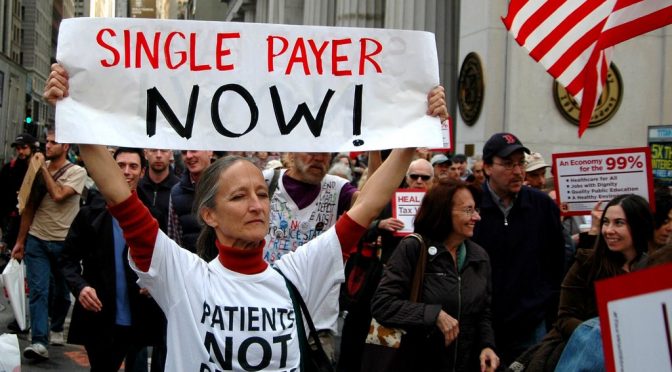
Will the Push to Dismantle Obamacare Lead to States Passing Single Payer Bills?
- Government, Human health, News, Politics
- ACA, Featured, healthcare, obamacare, single payer insurance
- August 9, 2017
The U.S. is the only one among modern, industrialized countries to not adopt some form of single payer healthcare. And Americans are paying dearly for it.
The U.S. is also the biggest spender on health care. An analysis by the Commonwealth Fund found that the U.S. spent 17.1 percent of its GDP on healthcare in 2013. That was much higher than what France spent at 11.6 percent of GDP and the U.K. at 8.8 percent.
High-priced healthcare
Private spending on healthcare is highest in the U.S. where the average spending per person in 2013 was $1,074 in out-of-pocket costs. France and the Netherlands spent less than one-fourth ($277 and $270, respectively).
The U.S. also spent much more than other countries in other private spending at $3,442 per capita, which was over five times more than Canadians spent at $654. Canada was the second highest spending country.
Riskier healthcare
A study comparing the U.S. and Canadian health care systems found that the Canadian system has “lower costs, more services, universal access to health care without financial barriers, and superior health status.” Researchers also found that Canadians have longer life expectancies and lower infant mortality rates than Americans.
The U.S. has the highest rate of deaths related to health care or the lack of it than among comparable countries, according to an analysis by the Kaiser Family Foundation. The disease burden is also higher in the U.S. and hospital admissions for preventable diseases occur more frequently than in comparable countries.
Increasing cost
Health care costs in the U.S. are expected to increase. Health Affairs projected that they will grow at 5.8 percent from 2015 to 2025, comprising 20.1 percent of the GDP.
The business world is taking note of the high health costs. Back in April, the American Sustainable Business Council launched the Business Leaders Transforming Healthcare campaign.
There are 128 companies supporting the campaign, ranging from small, mid-sized and large businesses in 30 states in sectors that include consumer products, finance, energy and real estate. The purpose of the campaign is to engage the business community in the U.S. to push for a single payer health care system.
Three states introduce single payer bills
California, New York and the state of Washington have all introduced single payer bills this year into their legislatures.
California
The Healthy California Act or SB 562, introduced in February, passed by the state senate in June. It now sits languishing in the Assembly.
The bill would create a Healthy California program to provide universal single-payer health care coverage. It would also create a health care cost control system.
The program would provide a “wide-range of medical benefits and other services.” It would incorporate in the “benefits and standards of other existing federal and state provisions,” including California’s Health Insurance Program (CHIP) and Medi-Cal.
The Healthy California board would use all “waivers, approvals, and agreements” so existing federal health care payments would be paid to the program.
Washington
Washington state House Bill 1026 would create a single-payer health care system by using the Affordable Care Act’s state innovation waiver 1332, which became available this year to state legislators.
With the waivers, states can use 95 percent of the federal funds provided to state residents for cost assistance to use for Affordable Care Act (ACA) alternatives. It would create the Washington Health Security Trust and create guidelines to establish board and advisory committees that would manage the health care of state residents.
New York
The New York Health Act passed in the state assembly in May. It would create a single payer health care system for the state of New York.
It would be paid for with payroll taxes and non-employment income such as capital gains. Introduced in February, the bill would seek “waivers and other approvals” that relate to federal programs such as Medicaid, the ACA, and Medicare.
An economic analysis of the bill found that the bill would save more than $70 billion in 2019, which is 25 percent of that year’s projected health care spending, with savings increasing over time. During the bill’s first year, it would save $44.7 billion, or almost $2,200 per person. The analysis also found that it would also create over 200,000 jobs, which would more than replace the jobs lost in insurance and billing.
Single payer healthcare makes sense
What states like those three understand is that a single payer system is not socialized medicine. Delivery of care would remain private, doctors would regain autonomy. The way to achieve universal, single payer health care in the U.S. just might be through the states. And if Republicans keep trying to dismantle the ACA, the states just might become emboldened to achieve what every other developed country has in place.
The way to achieve universal, single payer health care in the U.S. just might be through the states. And if Republicans keep trying to dismantle the ACA, the states just might become emboldened to achieve what every other developed country has in place.
And if Republicans keep trying to dismantle the ACA, the states just might become emboldened to achieve what every other developed country has in place.
Image credit: Michael Fleshman, courtesy Flickr




